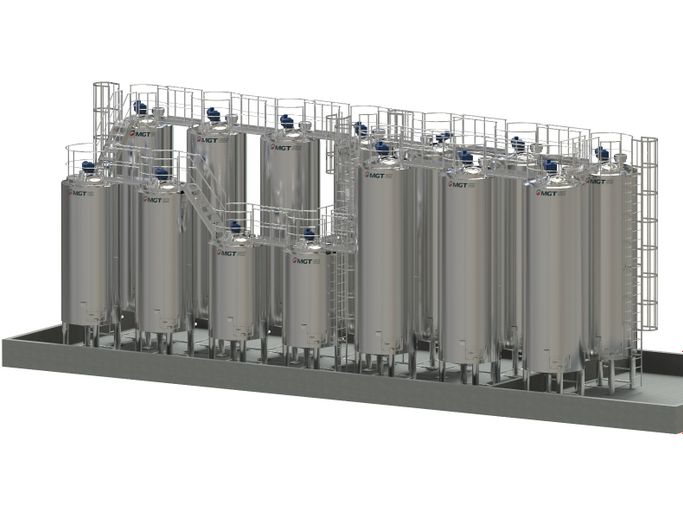Storage vessels play an important role in many industries. The material these vessels are made from will affect the properties of the contents. When choosing a storage vessel material, it is important to consider the options and decide which one will be the best for the particular application.
There are two common materials used for storage vessels: stainless steel and plastic. Stainless steel is an alloy of iron and chromium, and it is this chromium that gives it its corrosion-resistant properties. Plastic is a polymer, a material made up of long chains of molecules. Both materials have their pros and cons, and the best choice for a particular application will depend on the specific needs.
Durability and Longevity
When it comes to choosing storage vessels for various liquids, the two most common materials are stainless steel and plastic. Both have their own advantages and disadvantages, which should be considered when making a decision about which to use.
Stainless steel is more durable than plastic, meaning that it is more likely to last longer. This is because it is less likely to be scratched or damaged. Stainless steel is also more heat resistant than plastic, so it can be used for storing liquids that need to be kept at a high temperature.
However, plastic is more lightweight than stainless steel, so it is easier to transport. Plastic is also less expensive than stainless steel, so it may be a better option for those on a budget.
When it comes to durability and longevity, stainless steel is the better option. However, plastic has its own advantages that should be considered before making a decision about which material to use.
Safety and Food Contact
When it comes to storage materials for food and beverage products, there are two main contenders: stainless steel and plastic. Both have their pros and cons, but which is the better option? In this article, we’ll compare stainless steel and plastic storage vessels in terms of safety and food contact.
Stainless steel is a food-grade material that is safe for contact with food and beverage products. It is also non-porous, which means it won’t absorb flavors or odors from the food or beverage. Stainless steel is also easy to clean and sanitize.
However, stainless steel is a more expensive option than plastic. Additionally, it is a harder material, so it can be more difficult to work with.
Plastic is a less expensive option than stainless steel. It is also lightweight and easy to work with. Plastic is also non-porous, which means it won’t absorb flavors or odors from the food or beverage.
However, there are some safety concerns with plastic. Bisphenol A (BPA) is a chemical that is found in some plastics, and it can leach into food or beverage products. There is some evidence that BPA is harmful to human health, so it is important to choose a plastic storage vessel that is BPA-free. Additionally, some plastics are not meant for contact with food or beverages, so it is important to choose the right type of plastic for your needs.
Environmental Impact
The environmental impact of a product is the effect that it has on the environment throughout its life cycle. This includes the impact of the product’s manufacture, use, and disposal. Stainless steel and plastic are two of the most common materials used for storage vessels, so it is important to consider their environmental impact.
The manufacture of stainless steel involves mining of chromium and other metals, and the emissions from these processes can cause air and water pollution. The manufacturing process also uses a lot of energy, which can contribute to climate change. Plastic is made from petroleum, which is a non-renewable resource. The production of plastic also emits greenhouse gases and pollutes the air and water.
When it comes to the use of stainless steel and plastic storage vessels, both have benefits and drawbacks in terms of their environmental impact. Stainless steel is reusable and can be recycled, but it is often not recycled because it is difficult to recycle. Plastic is lighter than stainless steel, so it requires less energy to transport. However, plastic is not as durable as stainless steel and so it may not be used as often before it needs to be replaced.
Disposing of stainless steel and plastic can also have different impacts on the environment. Stainless steel can be recycled, but it can also take up a lot of space in landfills. Plastic can be recycled, but it can also release harmful chemicals into the environment when it is incinerated.
When considering the environmental impact of stainless steel and plastic storage vessels, it is important to consider the whole life cycle of the product. Stainless steel has a bigger impact during its manufacture, but plastic has a bigger impact during its use and disposal.
Cost and Maintenance
The initial cost of stainless steel storage vessels is generally higher than plastic vessels. However, the long-term cost and maintenance of stainless steel storage vessels is typically lower than plastic vessels. Stainless steel storage vessels are less likely to scratch and damage than plastic vessels, and they are also easier to clean. In addition, stainless steel storage vessels do not absorb flavors or odors, and they are more durable than plastic vessels.
Use Cases and Versatility
“Stainless steel is an ideal material for storage vessels because it is inert and non-reactive. This means that it won’t leach chemicals into your food or water, and it won’t corrode over time. Stainless steel is also very durable, so it can withstand being dropped or dented.
Plastic is a more versatile material than stainless steel, so it can be used for a wider range of applications. Plastic is lighter than stainless steel, so it is easier to carry and transport. Plastic is also less expensive than stainless steel, so it is a good choice for budget-conscious consumers.
When deciding which material to use for your storage vessel, it is important to consider your needs and preferences. If you need a durable, reliable vessel that won’t leach chemicals, stainless steel is a good choice. If you need a lighter, more affordable option, plastic may be a better choice.
While both plastic and stainless steel have their pros and cons, it’s important to remember that each type of storage vessel has a specific purpose. If you’re looking for an all-purpose storage vessel that can be used for a variety of things, stainless steel is the way to go. However, if you need something specifically for food storage or you’re looking for a more lightweight option, plastic may be the better choice.

